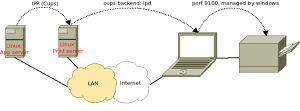Today, my dear wife asked me to help her with her facebook addiction. She wondered if I could block facebook, gmail, some news sites and more during her work hours. Sure, I can. And since she's running Linux as well, I could even do it on her own computer.
Step 1: Install squid
Squid is a FLOSS proxy server that runs on Linux and several other sytems. It's capable of filtering and behaving transparently. Just what we need.
yum -y install squid
Step 2: Configure squid
acl manager proto cache_object
acl localhost src 127.0.0.1/32 ::1
acl to_localhost dst 127.0.0.0/8 0.0.0.0/32 ::1
# Example rule allowing access from your local networks.
# Adapt to list your (internal) IP networks from where browsing
# should be allowed
acl localnet src 10.0.0.0/8 # RFC1918 possible internal network
acl localnet src 172.16.0.0/12 # RFC1918 possible internal network
acl localnet src 192.168.0.0/16 # RFC1918 possible internal network
acl localnet src fc00::/7 # RFC 4193 local private network range
acl localnet src fe80::/10 # RFC 4291 link-local (directly plugged) machines
acl SSL_ports port 443
acl Safe_ports port 80 # http
acl Safe_ports port 21 # ftp
acl Safe_ports port 443 # https
acl Safe_ports port 70 # gopher
acl Safe_ports port 210 # wais
acl Safe_ports port 1025-65535 # unregistered ports
acl Safe_ports port 280 # http-mgmt
acl Safe_ports port 488 # gss-http
acl Safe_ports port 591 # filemaker
acl Safe_ports port 777 # multiling http
acl CONNECT method CONNECT
# Here I define the times and what file contains the rules
acl playtime1 time SMTWHFA 8:30-9:30
acl playtime22 time SMTWHFA 16:00-17:00
acl addiction url_regex -i "/etc/squid/addiction"
# Only allow cachemgr access from localhost
http_access allow manager localhost
http_access deny manager
# Deny requests to certain unsafe ports
http_access deny !Safe_ports
# Deny CONNECT to other than secure SSL ports
http_access deny CONNECT !SSL_ports
# We strongly recommend the following be uncommented to protect innocent
# web applications running on the proxy server who think the only
# one who can access services on "localhost" is a local user
#http_access deny to_localhost
#
# INSERT YOUR OWN RULE(S) HERE TO ALLOW ACCESS FROM YOUR CLIENTS
#
# The next few lines actually do the work
http_access allow playtime1 addiction
http_access allow playtime2 addiction
http_access deny addiction
# If this ACL is triggered, show the user the WORKONLY error message.
deny_info WORKONLY addiction
# Example rule allowing access from your local networks.
# Adapt localnet in the ACL section to list your (internal) IP networks
# from where browsing should be allowed
http_access allow localnet
http_access allow localhost
# And finally deny all other access to this proxy
http_access deny all
# Squid normally listens to port 3128
# I added the word "transparent", so squid behaves a little different:
# it makes itself transparent. NOTE TO SELF: This is the line you're
looking for. Used to be httpd_accel_uses_host_header in squid 2
http_port 3128 transparent
# We recommend you to use at least the following line.
hierarchy_stoplist cgi-bin ?
# Uncomment and adjust the following to add a disk cache directory.
#cache_dir ufs /var/spool/squid 100 16 256
# Leave coredumps in the first cache dir
coredump_dir /var/spool/squid
# Add any of your own refresh_pattern entries above these.
refresh_pattern ^ftp: 1440 20% 10080
refresh_pattern ^gopher: 1440 0% 1440
refresh_pattern -i (/cgi-bin/|\?) 0 0% 0
refresh_pattern . 0 20% 4320
# Don't show squid to the outside world
forwarded_for delete
# I don't need to log what she's doing
access_log none
# Nor do i need icap logs
icap_log none
# And i don't want to know what is stored in cache
cache_store_log none
# To not break web apps, I don't want caching either
cache deny all
Step 3: Define blocked sites
Type a list of blocked websites in /etc/squid/addiction. You can use complete urls, domains or even just words. Ie. "facebook" blocks http://www.facebook.com, but also http://wikipedia.org/wiki/facebook
Step 4: Leave a message
In the configuration, I put: deny_info WORKONLY addiction. This means that I can leave the user a message in /usr/share/squid/errors/templates/WORKONLY and /usr/share/squid/errors/en/WORKONLY. Since it's my wife's PC, I decided to leave her a sweet message :-D
Step 5: Route network traffic
I could configure her Firefox to use the proxy. But then she'd use Google Chrome or Konqueror to surf the web. And she could turn the proxy off. So I need to catch all http-traffic that did not pass squid. I used iptables:
#Allow user 'root' to surf the web, for yum update etc.
iptables -t nat -A OUTPUT -m tcp -p tcp --dport 80 -m owner --uid-owner root -j RETURN
# Allow user 'squid' to pass on http requests
iptables -t nat -A OUTPUT -m tcp -p tcp --dport 80 -m owner --uid-owner squid -j RETURN
# Redirect all other traffic to the proxy.
iptables -t nat -A OUTPUT -m tcp -p tcp --dport 80 -j REDIRECT --to-ports 3128 |
#Allow user 'root' to surf the web, for yum update etc.
iptables -t nat -A OUTPUT -m tcp -p tcp --dport 80 -m owner --uid-owner root -j RETURN
# Allow user 'squid' to pass on http requests
iptables -t nat -A OUTPUT -m tcp -p tcp --dport 80 -m owner --uid-owner squid -j RETURN
# Redirect all other traffic to the proxy.
iptables -t nat -A OUTPUT -m tcp -p tcp --dport 80 -j REDIRECT --to-ports 3128




 (4 votes, average: 4.25 out of 5)
(4 votes, average: 4.25 out of 5)
 Loading...
Loading...


 (4 votes, average: 4.25 out of 5)
(4 votes, average: 4.25 out of 5)